The organised character of Nuh violence is reminiscent of the demand for sovereign ‘Meostan’ stretching from Mehrauli in Delhi to Bandikui in Dausa, Rajasthan, raised in 1946-47, ahead of India’s Partition.
Mewat’s Nuh district has almost always been in the news for the wrong reasons – cyber crime, cattle smuggling, abductions, molestation and rapes, forced conversions, murders, attacks on Dalits, and what not. Yet it cannot be categorised simply as a crime hub. The recent violent attack on a Shiv Yatra in this Muslim majority region has a larger message for the entire nation, and especially Hindus.
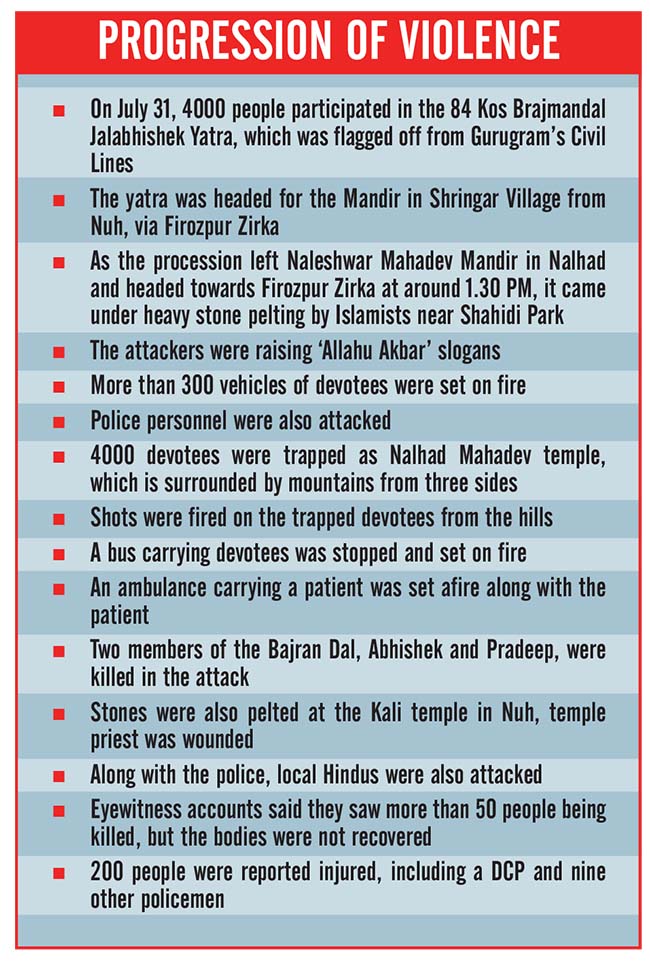
Nuh has not only identified itself with the pan-India pattern of attacks on Hindus, it has upped the ante by cornering close to 4000 devotees in a temple and firing at them with impunity despite heavy police presence. The fact that the incoming police force had to rescue the hostages secretly through the fields, because the roads were under Islamist siege, is something that should worry us intensely – the administrators and the people of a country that prides itself for being a democratic and freedom-loving society.
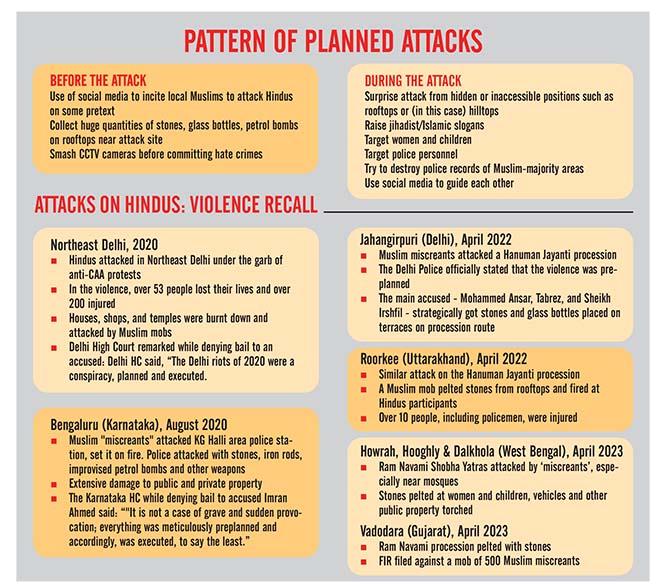
Radical Islamists in India, with of course foreign support, have standardised a toolkit for attacks on Hindus wherever the former are in significant number. Social media platforms have become a source of quick and smooth coordination before, during and after the attacks. The target is clear: Hindus in general, and their festivals and religious occasions in particular. The recent attacks on Ram Navami processions in Bengal, Hanuman Jayanti yatras in Delhi and Uttarakhand, Bengaluru violence on the pretext of a social media post, Northeast Delhi attacks on the CAA excuse… are just a few cases in point.
IN THE WORDS OF THE ADGP
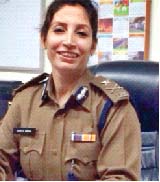
Mamata Singh, ADGP Law and Order, led the police squad that saved the 2500–3000 Hindus who were trapped in a hostage situation at the Nalhar temple
In a video shared on Twitter by India TV, the IPS officer recounted how the Islamists, armed with stones and sophisticated weapons, carried out the planned attack on the Hindu devotees. In her words:
“Large-scale firing was going on from three sides, from the hills surrounding the temple
Police were present in large numbers but were still outnumbered by the rioters
Police had to use retaliatory firing so that we could get cover to enter the temple and free the trapped devotees
The shooting continued even after the sun set Rioters were deliberately firing in the direction where they spotted bigger groups of devotees, in order to cause maximum damage
We realised we would have to evacuate the devotees in small groups
I first led the women out of the temple. They were all petrified. We had to calm them down as well as make sure they were safely evacuated. It was a mammoth task”
Unfortunately, the mainstream media, which is a critical player in this era of information warfare, frequently chooses to be partisan in the name of being ‘secular’. Their reluctance to identify attackers when the victims are Hindus is not just unfathomable, but downright unprofessional.
PRE-PLANNED ATTACK
- Before July 31, one Mohammed Sabir Khan shares a post on Facebook, with a video of gas cylinders lined up on a road that says: “If Monu (Manesar) comes to Mewat, we will burn down everything”.
- On July 31, some time after the Jalabhishek Yatra had started, one Rahees Khan Rangaliya posts on Facebook – “Kucch der mein Nuh mein, Inshallah” (It will reach Nuh shortly, Inshallah).
- One Arbaz Khan Dahngal, and one Aaysha Nawaj posted live updates of the cavalcade of VHP members en route to Mewat in the yatra.
- Mohammed Sabir Khan then writes a post instructing the men to be ready in larger numbers than ‘them’ (the yatris) and to quietly move with the yatris, both in the front and at the back, so they can be ambushed at an opportune moment.
- In another Facebook chat, truck and dumper drivers were urged to be prepared.
- After the riots, they urged each other to delete their social media posts and videos so that there was no evidence.
These are just a few pointers to the coordination happening during the attack on Hindu devotees in Nuh.
When on July 31, the devotees commenced the Brajmandal Jalabhishek Yatra, they had no clue they were in for a vicious attack, with swords and gunfire, by a radical Muslim mob. Women, children and elderly people were participating in the yatra. Bajrang Dal volunteers Abhishek Rajput and Pradeep Sharma were selectively targeted. Sweet seller Shakti Saini was returning home from his shop when he was killed, just because he was Hindu. Abhishek suffered the most brutal attack – he was first shot, later the attackers slit his throat and hit him with stones. Pradeep too was ruthlessly beaten up and breathed his last at Delhi’s Safdarjung Hospital on August 2. Two Homeguards, Neeraj and Gurusewak, were also killed.
Horrific experience

While talking to ‘Sudarshan News’, a Hindu woman narrated the horrific story of the Nuh riot. She said, “Hindu brothers were outside when shots were fired from the surrounding bushes. Some miscreants managed to infiltrate the Electricity Department and turn off power. They were waiting for the sun to set and for the night to fall in order to harass Hindu women sexually. Only we know how we preserved our honour. We have witnessed the deaths of our brethren. We know how our brothers were shot. We didn’t even have bandages to cover their wounds, so we tied our stoles on them. Did we travel there to die? Can’t we offer ‘darshan’ there? These people also take out their processions. Do any of us object to them? We lacked even access to water. We wet our throats with the water that was poured on the shivling.”

Another victim said, “We didn’t have water to drink while being harassed by Muslim youth. So, we drank toilet water. Bullets were being fired from everywhere. There were also children and old people in this yatra. Stone were pelted on them too. They were waiting for the sun to set.”
While the official death toll was six, including five Hindus, eyewitnesses said they had seen over 50 devotees being killed at the temple site – though their bodies were not recovered. There are reports of missing people, and the investigations are on. About 200 people were reported wounded in the attack including ten policemen, one of them a Deputy Commissioner of Police (DCP). Over 300 vehicles were set on fire.
THE SIGNIFICANCE OF NUH
Nuh is home to three Shiva lingas from the era of the Pandavas in the ‘Mahabharat’. It is also believed that Bhagwan Shri Krishna used to graze his cows here. The yatra, which enters Mewat from Sohna, begins with a ceremonial jal abhishek (pouring of sacred water)” at the Nalhar Mahadev Temple. Surrounded by the Aravallis, this ancient temple is near the main Nuh town and is said to date back to the time of the Pandavas. It is also home to a pond called the Nalhar Pandava Reservoir. After the jal abhishek, devotees pay obeisance at the Jhirakeshwar Mahadev and the Radha Krishna Temple in Shringar village in Punhana Tehsil of Nuh. They then visit the Shringeshwar
Mahadev Temple, where another “jal abhishek” ceremony takes place.
THOSE WHO SOUGHT ‘MEOSTAN’
What is known as the Mewat region extends beyond Haryana, into Alwar, Dausa and Bharatpur districts of Rajasthan and Mathura district of Uttar Pradesh. This region lies at the heart of the “golden triangle” tourist circuit comprising Delhi, Agra and Jaipur.
Five Hindus killed by the mob
Shakti Singh
Shakti Singh, who was returning to his home after doing his work at a sweet shop, was beaten to death by Muslim mob. A father of four children, Shakti was the lone earner for his family.
Abhishek
Abhishek , who was volunteer of Bajrang Dal, was first shot. Later, rioters slit his throat and hit him with stones
Neeraj Kumar
Niraj, a homeguard of Gurugram Police, was killed by Muslim mob, who attacked him with sticks and crushed him with stones
Gurusewak
Gurusewak was killed due to stone pelting. He was attacked by rioters when he was going to Mewat from Gurugram
Pradeep Sharma
A volunteer of Bajrang Dal, Pradeep Sharma was ruthlessly beaten by the Muslim mob, who died on August 2 at Safdarjung Hospital while undergoing treatment
During the tumultuous times of 1946-47, the demand for a separate ‘Meostan’ was raised by Communist Meo leader Kunwar Mohammed Ashraf and section of the Rajputana Muslim League (comprising Meos of Alwar and Bharatpur). The plan was to achieve Meostan, envisaged as adjacent to Pakistan. Their assumption was that the whole of Punjab (today’s Haryana and Himachal Pradesh), as demanded by Jinnah, would fall into the lap of Pakistan.
“We received a report that 400-500 anti-social elements had forced 35-40 people inside the Ram Mandir in Ward No. 9 in Nuh and were not allowing them to leave. When I reached near the Ram Mandir, I saw a mob of 400-500 anti-social elements armed with sticks, stones and illegal weapons who were attacking with the intent to kill”
–Duty Magistrate Abid Hussain in an FIR
As the embers cooled off after the independence and partition, the Nehru government tried to repatriate the Meos who had crossed over to Pakistan. Criticising this policy, Sardar Bhopinder Singh stated in the Constituent Assembly on August 12, 1949: “Meos from Gurgaon, Bharatpur and Alwar not very long time ago, on the inspiration of Muslim League, demanded Meostan and they were involved in a very serious rioting against the Hindus — their neighbours — at the time of freedom. Right in 1947, a serious riot was going on by these Meos against their Hindu neighbours. These Meos, under this very lax permit system, are returning and demanding their property. On the other hand, we are short of property and the other hand concessions are being given to them. This is secularism no doubt, but a very one-sided and undesirable type of secularism which goes invariably against and to the prejudice of Sikh and Hindu refugees. I do not want to give rights of citizenship to those who so flagrantly dishonoured the integrity of India not long ago.”
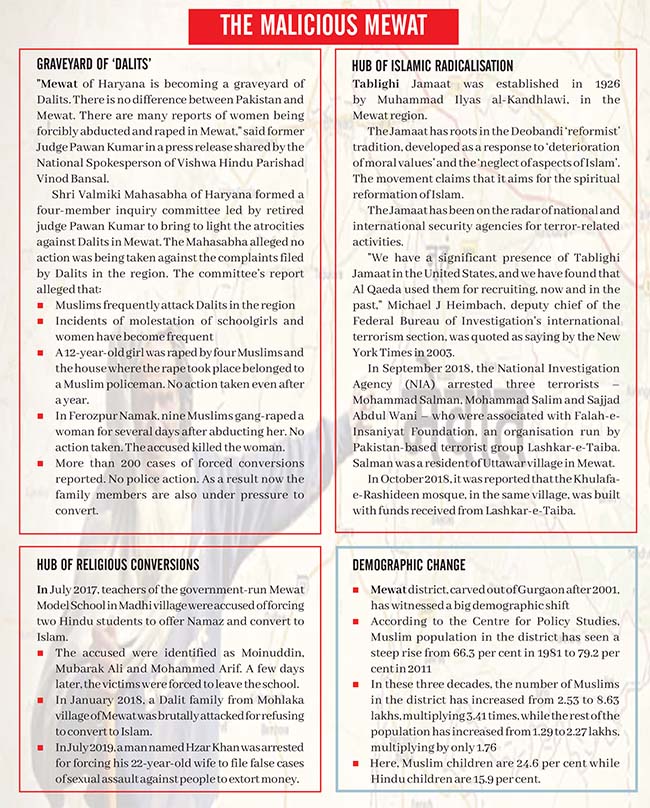
Today, as we celebrate 75 years of independence as the Amrit Kaal, India needs to rectify the mistakes of the past. Because if we do not learn for history, history will repeat again and again.



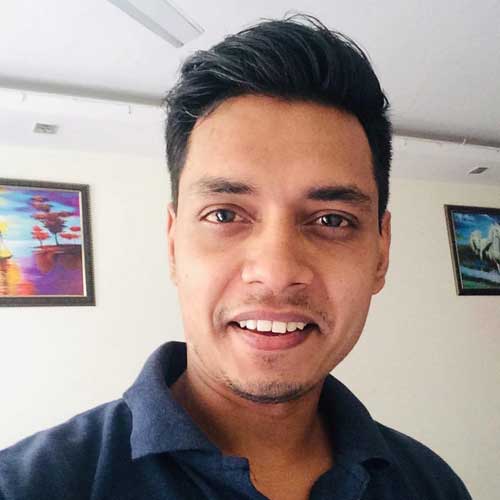
















Comments